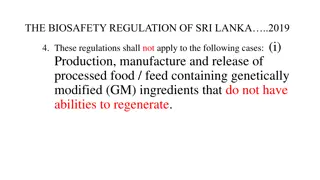Understanding Genetically Engineered Foods: Perspectives and Insights
FDA ensures the safety of genetically engineered (GMO) foods, EPA reviews their environmental impact, farmers benefit from improved crop management, some consumers prefer non-GMO products, and nutritionally, GM foods are similar to non-GM. While scientific consensus supports the safety of GMOs, global acceptance varies.
Download Presentation

Please find below an Image/Link to download the presentation.
The content on the website is provided AS IS for your information and personal use only. It may not be sold, licensed, or shared on other websites without obtaining consent from the author. Download presentation by click this link. If you encounter any issues during the download, it is possible that the publisher has removed the file from their server.
E N D
Presentation Transcript
Genetically Engineered (GMO) Foods from my point of view #1 FDA (Food & Drug Administration) Foods derived from a genetically engineered plant pose no greater risk in terms of food safety than foods from non- GE plants. For FDA approval, foods from genetically engineered plants meet the same food safety requirements as foods from traditionally bred plants. Background Information: The Food & Drug Administration regulates the safety of food for humans and animals, including foods produced from genetically engineered (GE) plants. Before a genetically engineered crop is approved for commercial growth, the FDA does thorough testing to be sure it meets all food safety requirements.
Genetically Engineered (GMO) Foods from my point of view #2 EPA (Environmental Protection Agency) Genetically engineered crops are safe for the environment. Background Information: The EPA focuses on reviewing the environmental impacts of a GE crop prior to field-testing and the commercial release of the seed. They ensure there are no unintended consequences to honeybees, other beneficial insects, earthworms, fish, or the environment in general.10They also look for any possible impact on other crops.
Genetically Engineered (GMO) Foods from my point of view #3 Farmer Genetically engineered seed varieties allow farmers to manage weeds, pests, and plant diseases. For example: Weeds: Some GE plants are resistant to glyphosate, an herbicide. Farmers can spray their fields and kill all the weeds (unwanted plants) without harming their crop. Pests: Some GE plants are naturally resistant to pests that destroy crops. This eliminates the need to spray pesticides. Plant Diseases: Some GE plants are naturally resistant to diseases that would otherwise destroy the plant. Background Information: Many methods can be used to control weeds, pests, and disease in crops. The effectiveness of each control method varies. Eighteen million farmers in 28 nations around the world (20 developing countries and 8 industrialized nations) cultivate GM crops on nearly 450 million acres. However, some farmers also elect to use non-GMO seeds for a variety of reasons including to certify for an organic label.
Genetically Engineered (GMO) Foods from my point of view #4 Food Marketer Some consumers fear GMO foods and prefer to purchase foods labeled as non-GMO. In context of global food trade, some countries ban the importation and cultivation of genetically engineered crops. Background Information: Although science has deemed genetically engineered food crops safe for human consumption and safe for our environment, they are not universally accepted and trusted. Russia has banned the importation and cultivation of genetically engineered crops.
Genetically Engineered (GMO) Foods from my point of view #5 Nutritionist The levels of vitamins and other nutrients found in GM foods are the same as those found in non-GM foods. Background Information: Fortification is a process that adds nutritional value to a food. This is usually done in processing. However, biofortification can improve the nutritional content of a food using its genetics. Golden Rice is a genetically engineered variety of rice with increased vitamin A content. Developing countries could dramatically decrease the instance of nutrition- related disease by growing biofortified food. Although Golden Rice has been developed, it has not been approved for commercial use yet. It is an example of potential benefit.
Genetically Engineered (GMO) Foods from my point of view #6 Consumer Some consumers are indifferent about their foods containing genetically engineered plants. Some consumers are opposed to GMO foods despite scientific studies that say they are as safe as non-GMO foods. Some consumers are in favor of GMO foods and recognize the benefits they provide to our environment and food supply. (Did you know genetic engineering in plants can produce more crops on less land?)


![❤[PDF]⚡ Escaping from Eden: Does Genesis Teach that the Human Race was Created](/thumb/21697/pdf-escaping-from-eden-does-genesis-teach-that-the-human-race-was-created.jpg)




















